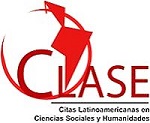Thirlwall`s law: theoretical and empirical evidence. The Mexican and Argentinian cases in 1960-2014.
DOI:
https://doi.org/10.33571/teuken.v8n11a5Keywords:
economic growth, balance of payments, Thirlwall`s lawAbstract
This article analyses the theoretical and empirical determinants of the Thirlwall ́s Law. It stablishes if they are important to explain the Argentina`s and Mexico ́s growth problems during 1960-2014. This paper utilizes two methodologists. First, it develops a theoretical model which highlights the importance of demand and structural factors as the principal obstacle to the growth process of an economy. Second, it uses historical data to estimate the relevant Thirlwall coefficients through econometric models. The most important result of this investigation is that the Thirlwall law is relevant to explain Argentina ́s growth problems, but it is not the case for Mexico.Article Metrics
Abstract: 1091 PDF (Español (España)): 1215PlumX metrics
References
ABELES, Martín, LAVARELLO, Pablo y MONTAGU, Haroldo. (2013). Heterogeneidad estructural y restricción externa en la economía argentina. En: INFANTE, Ricardo y GERSTENFELD, Pascual, eds. Hacia un desarrollo inclusivo: el caso de la Argentina. Santiago de Chile-CEPAL, OIT.
ACEMOGLU, Daron & ROBINSON, James. (2012). Why Nations Fail? The origins of power, prosperity, and poverty. Crown Business, Nueva York-Crown Business
AMICO, Fabián, FIORITO, Alejandro y HANG, Guillermo. (2011). Producto potencial y demanda en el largo plazo: hechos estilizados y reflexiones sobre el caso argentino reciente. CEFID-AR. Documento de trabajo Nº35, enero, 2011. Buenos Aires-CEFID-AR
CALDENTEY, Esteban. (2015, abril-junio). Una lectura crítica de ‘la lectura crítica’ de la Ley de Thirlwall. En: Investigación Económica, LXXIV(292), 47-65. Ciudad de México-UNAM.
CALDENTEY, Esteban. (2016). A time to reflect on opportunities for debate and dialogue between (neo)structuralism and heterodox schools of thought. En: BÁRCENA, Alicia y PRADO, Antonio, eds. Neostructuralism and heterodox thinking in Latin America and the Caribbean in the early twenty-first century. Santiago de Chile-CEPAL.
CLAVIJO, Pedro y ROS, Jaime (2015, abril-junio). La Ley de Thirlwall: una lectura crítica. En: Investigación Económica, LXXIV(292), 11-40. Ciudad de México-UNAM
FURTADO, Celso. (1956). Manual of Programming and Economic Development Promotion. Nueva York- Naciones Unidas.
IBARRA, Carlos. (2015, abril-junio). Comentario a “La Ley de Thirlwall: una lectura crítica” de Pedro Clavijo y Jaime Ros. En: Investigación Económica, LXXIV (292), 41- 45. Ciudad de México-UNAM.
JOHANEN, Søren. (1995). Likelihood-Based Inference in Cointegrated Vector Autoregressive Models. Oxford University Press. Oxford.
KEMP, Murray. (2008). Marshall–Lerner condition. En: The New Palgrave Dictionary of Economics. Segunda edición. Eds.: S. N. Durlauf y L. E. Blume. Nueva YorkPalgrave Macmillan
MANZANELLI, Pablo, BARRERA, Mariano, WAINER, Andrés y BONA, Leandro (2015, abril). Deuda externa, fuga de capitales y restricción externa. Desde la última dictadura militar hasta la actualidad. CEFID-AR. Documento de Trabajo Nº 68. Buenos Aires-CEFID-AR.
McCOMBIE, John. (1997). On the empirics of balance-of-payments-constrained growth. En: Journal of Post Keynesian Economics, 19, 345–75. Nueva York-LondresTaylor y Francis.
MORENO, Juan y ROS, Jaime. (2010). Desarrollo y crecimiento en la economía mexicana. Una perspectiva histórica. Ciudad de México-Fondo de Cultura Económica.
MORENO, Juan. (2003). Capital Flows, Interest Payments and The BalanceofPayments Constrained Growth Model: A theoretical and Empirical Analysis. En: Metroeconomica, 54(2 & 3), 346–365. Roma-John Wiley e Hijos Ltd.
PERROTINI, Ignacio (2002, jul-dic). La ley de Thirlwall y el crecimiento en la economía global: análisis crítico del debate. En: Revista Venezolana de Análisis de Coyuntura, VIII(2), 117-141. Caracas-Universidad Central de Venezuela.
PREBISCH, Raúl (1949). El desarrollo económico de la América Latina y algunos de sus principales problemas. En: Desarrollo Económico, 26(103). (Oct - Dec., 1986), 479-502. Buenos Aires-Universidad De Buenos Aires.
RODRIK, Andy. (2008). The real exchange rate and economic growth. Brookings Papers on Economic Activity, 2, 365-412. Nueva York-BP.
ROS, Jaime, (2013). Latin America’s Trade and Growth Patterns, the China Factor, and Prebisch’s Nightmare. En: Journal of Globalization and Development. Nueva York-Banco Mundial.
THIRLWALL, Anthony (2003). La naturaleza del crecimiento económico. Un marco alternativo para comprender el desempeño de las naciones. Fondo de Cultura Económica, Ciudad de México, 2003.
THIRLWALL, Anthony y HUSSAIN, Nureldin (1982). The Balance of Payments Constraint, Capital Flows and Growth Rate Differences between Developing Countries, Oxford Economic Papers, 34(3), 498-510. Londres-Oxford University Press.
THIRLWALL, Anthony. (1979). The balance of payments constraint as an explanation of the international growth rate differences, En: Banca Nazionale del Lavoro Quarterly Review, 128, 45-53. Roma-Banca Nazionale del Lavoro.
VERNENGO, Matías. (2015). Una lectura crítica de la crítica al modelo de Thirlwall. En: Investigación Económica, LXXIV (292), 67-80. Ciudad de México-Universidad Nacional Autónoma de México.

























